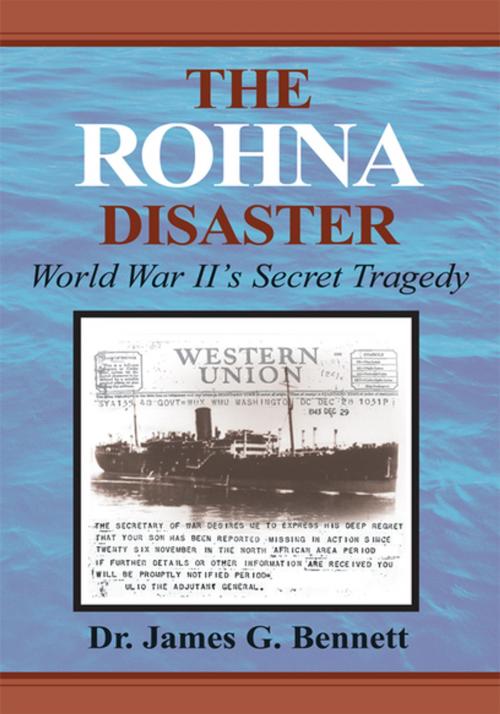| Author: | Dr. James G. Bennett | ISBN: | 9781469106168 |
| Publisher: | Xlibris US | Publication: | December 20, 1998 |
| Imprint: | Xlibris US | Language: | English |
| Author: | Dr. James G. Bennett |
| ISBN: | 9781469106168 |
| Publisher: | Xlibris US |
| Publication: | December 20, 1998 |
| Imprint: | Xlibris US |
| Language: | English |
"A gripping true-to-life account of a tragic incident in U.S. history that needs to be read by everyone." Congressman Jack Metcalf, U.S. House of Representatives.
THE DAY AFTER THANKSGIVING
On November 26, 1943, one day after Thanksgiving and one day out to sea, one thousand, nine-hundred and eighty one young American soldiers were presented with the most challenging and terrifying experience of their lives. On that day, they became players in what was to become one of the greatest at-sea tragedies in United States history. More than half of them never survived to tell their story.
On that day, two of the WWIIs least known but historic incidents occurred. The United States suffered its greatest loss of troops at-sea in its history when the HMT ROHNA a British transport was sunk by a guided missile launched from a German bomber over the Mediterranean Sea, off the coast of North Africa. The ship, with officers and crew of one hundred ninety five was transporting American troops and Red Cross workers to the China-Burma-India Theater of war
One thousand and fifteen American troops, three Red Cross workers and one hundred and twenty ships officers and crewmen perished, a loss second only to that of the Arizona at Pearl Harbor. In addition to the record number of casualties that were incurred, the bombing itself was historic because it was the first ever, successful "hit" by a remote-controlled rocket-boosted bomb, launched in the air from a German bomber, on a merchant vessel chartered for military use in war time. This incident was, in effect, the dawning of the missile age.
The ship, badly in disrepair, was part of Convoy KMF-26 en-route to Bombay, India with men and supplies needed for the little known China - Burma -India theater of WWII.
It was a noteworthy historic event that received little notice and still has not been acknowledged by the United States government. Understandably, for security reasons, the War Department immediately suppressed news of this catastrophe.
Compounding this tragedy, no details were ever provided to the grieving fathers and mothers. Parents went to their graves never to learn the fate of their sons. Families still do not know how their loved ones died and this disaster continues to remain virtually unknown to the public. Over eight hundred bodies were never recovered, and their remains are scattered over hundreds of miles at the bottom of the Mediterranean Sea.
THE ROHNA DISASTER (227P) describes that tragic, but little known incident at sea. Each chapter presents electrifying eyewitness accounts of the inhumane shipboard conditions, the actual bombing and sinking, and the struggles to survive and be rescued in heavy seas at night. Accounts of heroism and courage are woven through each chapter, and the anquish of families, as they waited fifty years in an emotional void, is poignantly told.
THE ROHNA DISASTER is, in many respects, told by the people who played their different roles as survivors, rescuers and family members. Every survivor was willing, if not anxious, to share his experience, painful though it often was, some because they wanted to help the author in his search for information about his brother, most, because they felt very strongly that this story should be told and that the casualties should be given an honored place in American history.
It is important that history be chronicled, and that this story, an important part of our history, be told, heard, taught and remembered. It is also important that those who played roles in this incredible drama, the survivors, rescuers and casualties, be given their due honor and recognition, and that the families of those who perished, who have a right to know what happened to their loved ones, be given an opportunity to learn that truth. This book was written for those reasons.
"We are slowly losing a unique breed of people, the likes of which we will never s
"A gripping true-to-life account of a tragic incident in U.S. history that needs to be read by everyone." Congressman Jack Metcalf, U.S. House of Representatives.
THE DAY AFTER THANKSGIVING
On November 26, 1943, one day after Thanksgiving and one day out to sea, one thousand, nine-hundred and eighty one young American soldiers were presented with the most challenging and terrifying experience of their lives. On that day, they became players in what was to become one of the greatest at-sea tragedies in United States history. More than half of them never survived to tell their story.
On that day, two of the WWIIs least known but historic incidents occurred. The United States suffered its greatest loss of troops at-sea in its history when the HMT ROHNA a British transport was sunk by a guided missile launched from a German bomber over the Mediterranean Sea, off the coast of North Africa. The ship, with officers and crew of one hundred ninety five was transporting American troops and Red Cross workers to the China-Burma-India Theater of war
One thousand and fifteen American troops, three Red Cross workers and one hundred and twenty ships officers and crewmen perished, a loss second only to that of the Arizona at Pearl Harbor. In addition to the record number of casualties that were incurred, the bombing itself was historic because it was the first ever, successful "hit" by a remote-controlled rocket-boosted bomb, launched in the air from a German bomber, on a merchant vessel chartered for military use in war time. This incident was, in effect, the dawning of the missile age.
The ship, badly in disrepair, was part of Convoy KMF-26 en-route to Bombay, India with men and supplies needed for the little known China - Burma -India theater of WWII.
It was a noteworthy historic event that received little notice and still has not been acknowledged by the United States government. Understandably, for security reasons, the War Department immediately suppressed news of this catastrophe.
Compounding this tragedy, no details were ever provided to the grieving fathers and mothers. Parents went to their graves never to learn the fate of their sons. Families still do not know how their loved ones died and this disaster continues to remain virtually unknown to the public. Over eight hundred bodies were never recovered, and their remains are scattered over hundreds of miles at the bottom of the Mediterranean Sea.
THE ROHNA DISASTER (227P) describes that tragic, but little known incident at sea. Each chapter presents electrifying eyewitness accounts of the inhumane shipboard conditions, the actual bombing and sinking, and the struggles to survive and be rescued in heavy seas at night. Accounts of heroism and courage are woven through each chapter, and the anquish of families, as they waited fifty years in an emotional void, is poignantly told.
THE ROHNA DISASTER is, in many respects, told by the people who played their different roles as survivors, rescuers and family members. Every survivor was willing, if not anxious, to share his experience, painful though it often was, some because they wanted to help the author in his search for information about his brother, most, because they felt very strongly that this story should be told and that the casualties should be given an honored place in American history.
It is important that history be chronicled, and that this story, an important part of our history, be told, heard, taught and remembered. It is also important that those who played roles in this incredible drama, the survivors, rescuers and casualties, be given their due honor and recognition, and that the families of those who perished, who have a right to know what happened to their loved ones, be given an opportunity to learn that truth. This book was written for those reasons.
"We are slowly losing a unique breed of people, the likes of which we will never s















